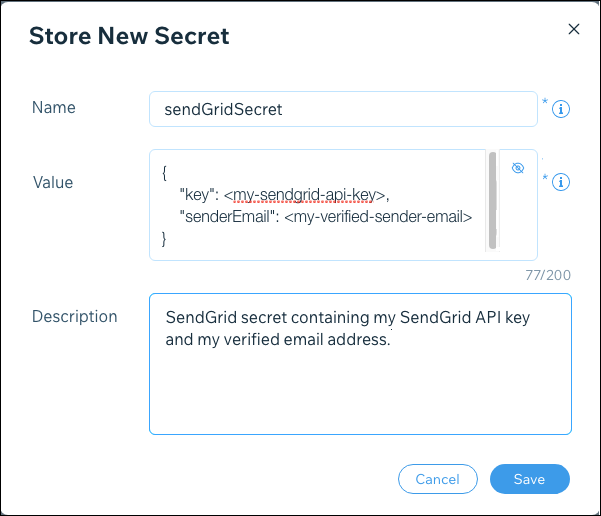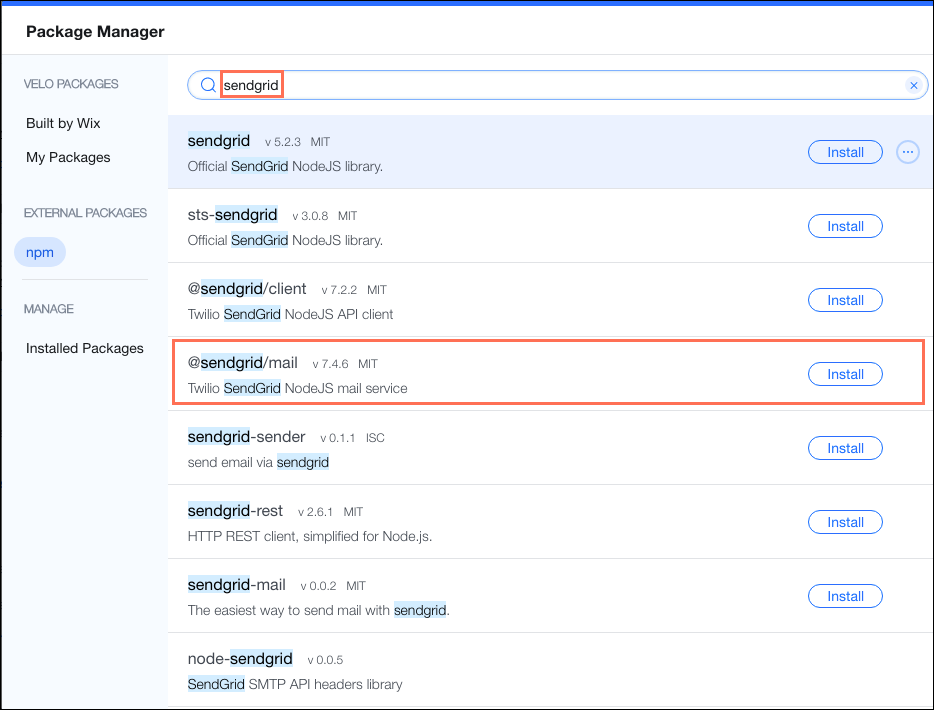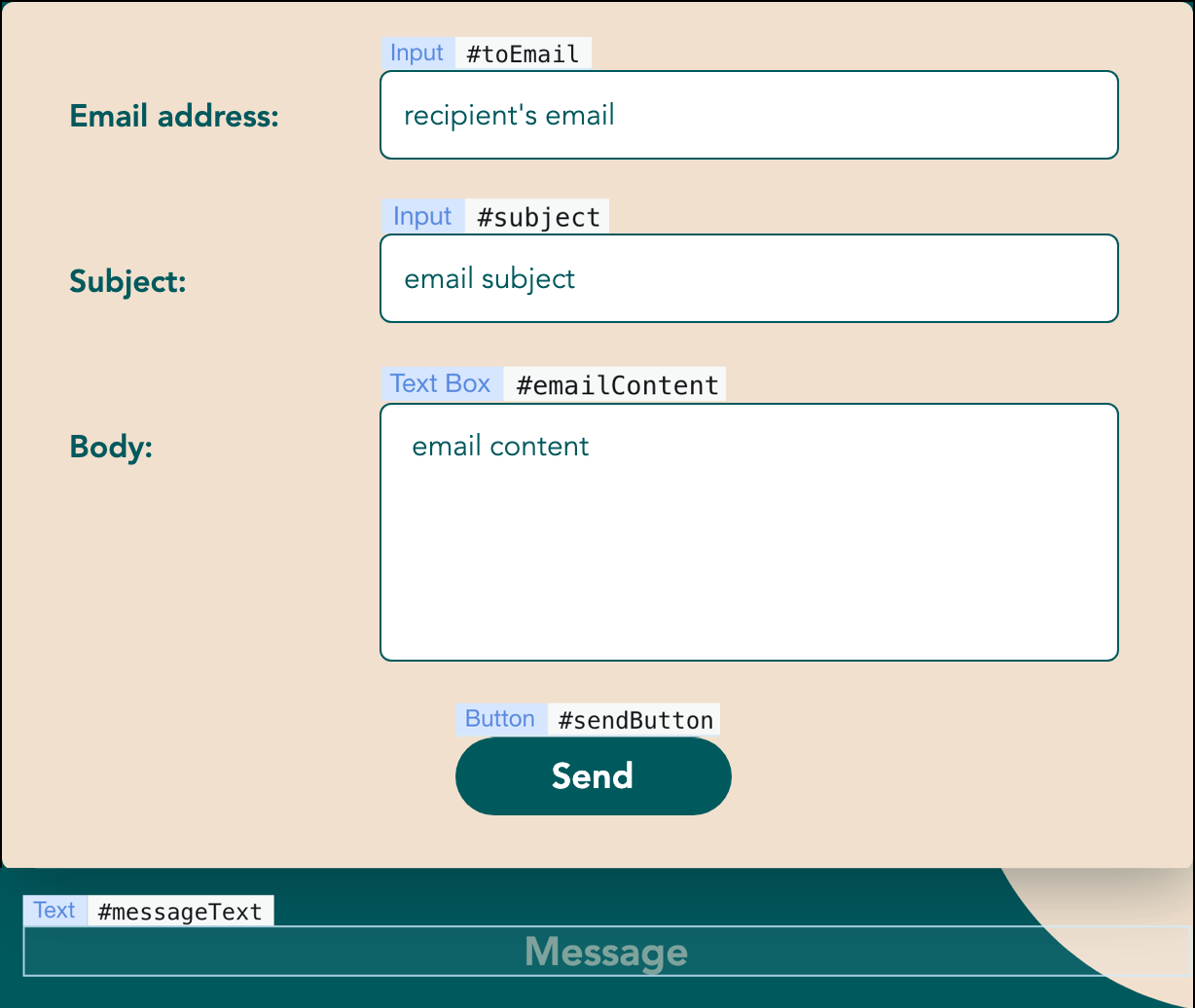Velo Tutorial: Send Emails Using the SendGrid npm Package
Note: This tutorial and its steps are based on a Wix Editor site. You can adapt the steps for a Wix Studio site by using the equivalent Wix Studio features.
This article describes how to integrate your Wix site with the SendGrid service and send emails directly from your site. You'll need to add the SendGrid npm package to your site to incorporate the SendGrid functionality.
This tutorial is based on the SendGrid npm Integration example. You can test out the live example site or open a copy of the site's editor and play around with the code.
Notes
- If you want to work with a copy of the example site, you'll need to create your own SendGrid account and save your email address and the SendGrid API key in the Secrets Manager (see detailed instructions below).
- You can also integrate your Wix site with SendGrid using the Fetch API.
Overview
To set up your site to send emails with the SendGrid service, you'll need to perform the following steps:
- Create a SendGrid account.
- Store the SendGrid API key and your sender email address in the Secrets Manager.
- Add the SendGrid npm package to your site.
- Add a custom form to your page for getting the recipient email address and email text from site visitors.
- Write code in a backend web module to get the API key from the Secrets Manager and send an email using an npm package function.
- Write page code to use the imported backend function to send an email, using the email data entered in the form fields.
Note This tutorial describes how to use a custom form to get email data such as email addresses and body text from site visitors. You might have a different use case, such as constructing the emails yourself as a site admin. You might use email data stored in a database collection, enter the email data directly in your code, or use the custom form but on a Dashboard page. In any case, you'll need to adjust your code to get the email data from its source and pass it to the sendEmail() function.
Step 1: Create an Account with SendGrid
To use the SendGrid service on your Wix site, you'll need to create a SendGrid account. The email address you verify in the account will be the sender address for the emails you send from your Wix site.
Once you've created an account, do the following:
- In the SendGrid site, navigate to the left menu.
- Go to Settings > Sender Authentication and verify your email address.
- Go to Settings > API Keys and generate an API key.
- Copy the key from your dashboard and store it in the Secrets Manager in your Wix site (see the next step).
Step 2: Set Up the Site
To set up your Wix site, do the following:
- Store secrets in the Secrets Manager.
- Add the SendGrid npm package to your site.
- Add elements to your page.
Step 2a: Store Secrets in the Secrets Manager
For security purposes, it's best to store sensitive content such as API keys in the Secrets Manager.
-
In the Code sidebar, select the Developer Tools
 tab.
tab. -
Under the Security section, select Secrets Manager.
-
In the top right, click Store Secret.
-
Store both your SendGrid API key and the verified email address associated with your SendGrid account in a single secret. The secret should look like this:

-
Make sure to name the secret: sendGridSecret.
-
Replace
<my-sendgrid-api-key>with the value of your API key surrounded by quotation marks. -
Replace
<my-verified-sender-email>with your email address surrounded by quotes. -
Your secret value will look something like this:
Copy
-
-
Click Save.
Later you'll use the Secrets API to extract the secret and use it securely in your code (see Step 3b).
Step 2b: Add the SendGrid npm Package
Use the Package Manager to add the SendGrid npm package to your site:
-
In the Code sidebar, click the Code Files
 tab.
tab. -
In the Packages section, hover over npm, click the plus icon
 and select Install package from npm.
and select Install package from npm.
The Package Manager opens.
-
In the search bar, enter 'sendgrid'.

-
Next to the @sendgrid/mail package, click Install.
You'll see the package under npm in the Packages section of your Code Files tab in the Code sidebar.

Now you can import the package and use its functionality in your code.
Step 2c: Add Page Elements
To create a custom form, add the following elements to your Home page:
-
Input elements for the recipient's email and subject line
-
Text box for the email body text
-
Submit button for sending the email
-
Text element for displaying success and error messages

Step 3: Write Backend Code in the sendEmail.web.js Web Module
Since backend code is more secure, we wrote code to implement the following functionality in a backend web module:
- Extract the SendGrid API key from the Secrets Manager.
- Set the API key in SendGrid.
- Send an email using a SendGrid npm package function.
Note To see all the code for this example in a single block, scroll down to the end of the tutorial.
Step 3a: Add a Web Module
Web modules are exclusive to Velo. In a web module you can write functions that run in the backend and are easily called in your frontend code.
To add a web module:
-
In the Code sidebar, select the Code Files
 tab.
tab. -
In the Backend section, click Add web module.

-
Name the file sendEmail.web.js.
The file will open in the code editor. Place the code below in the file.
Step 3b: Import Modules
Start by importing the modules you'll need:
Understanding the Code
Line 1: Import the Permissions enum and webMethod function from wix-web-module.
Line 2: Import the sgMail module containing the functions you need from the npm package that we added to our site.
Line 3: Import the wix-secrets-backend module for extracting secrets from the Secrets Manager.
Step 3c: Extract and Set the API Key
In our sendEmail function, we start by getting the SendGrid API key and sender email address that we saved in the Secrets Manager, and setting the API key to enable usage of the SendGrid service.
Understanding the Code
Line 1: Declare and export the asynchronous sendEmail function for sending the email.
Line 3: Get the SendGrid secret from the Secrets Manager using the getSecret function and save it in a variable named sendGridSecret. The JSON.parse function converts the JSON string into an object.
Line 4: Save the API key extracted from the secret as a variable called key.
Line 5: Save the sender email extracted from the secret as a variable called senderEmail.
Line 7: Set the API key using the setApiKey() function from the SendGrid npm module.
Step 3d: Send an Email
While still inside our sendEmail() function, we call the npm package send() function to send the email.
Understanding the Code
Lines 1-6: Set the data for the email to be sent, such as the recipent's email address and the text of the email body. The sender email was extracted from the Secrets Manager and the rest of the information is entered by site visitors on the frontend via input elements.
Lines 8, 10: Use try and catch to catch any errors.
Line 9: Call the send() npm package function to send the email with the email data passed to the function.
Step 4: Write Page Code in the Frontend
Note The frontend code for this tutorial is based on the setup for this example site, a custom form exposed to site visitors. If you decide to set up your site differently, you'll need to adapt the frontend code accordingly.
In our page code on the frontend of our site, we do the following:
- Get email information such as the recipient's email address and email text from site visitors via the custom form fields.
- Validate the form fields.
- Use the
sendEmail()function imported from the backend with the form field values to send an email. - Show a success or error message.
Step 4a: Setup
First we import the function we need from the backend and set a global constant.
Understanding the Code
Line 1: Import the sendEmail() function that we created in the backend so that we can use it in our page code.
Line 2: Set a SUCCESS_CODE constant to 202. We'll use it to check whether the sendEmail() function request was successful.
Step 4b: Validate the Form Fields
We added the checkFormFields() function to make sure all form field input values are valid before sending an email.
Understanding the Code
Line 1: Declare the function that we'll call in the onReady() function.
Line 2: If all input values are valid, return true. If one is not valid, return false.
Step 4c: Clear the Form Fields
We added the clearFields() function to reset the form fields following a successful email transmission.
Understanding the Code
Line 1: Declare the function that we'll call in the onReady() function.
Lines 2-4: Clear the input values.
Lines 6-8: Reset the inputs' visual validity indications. Some elements have a visual cue, such as a red outline, that indicates when the current value isn't valid. This function clears any indications.
Step 4d: Show Success and Error Messages
We added the showMessage() function to temporarily show a success or error message following an attempt to send an email.
Understanding the Code
Line 1: Declare the function that we'll call in the onReady() function.
Line 2: Set the message text with the text passed to the function.
Line 3: Show the success or error message.
Line 4: Hide the message after 5 seconds.
Step 4e: Send the Email when the Form Is Submitted
When a site visitor clicks the Send button, we do the following:
- Check whether all form field values are valid.
- If they're valid, send the email with the values extracted from the form inputs. If the form fields aren't valid, show an error message.
- If the email transmission request is successful, clear the form fields and display a success message. If the request fails, show an error message.
Understanding the Code
Line 1: We added our code to the onReady() function, which runs when the page loads.
Line 2: When a site visitor clicks the Send button, run the following code.
Lines 3-4: Check if all input field values are valid. If not, see Lines 15-16. If they are, run the following code.
Lines 5-8: Run the sendEmail() function that we imported from the backend with the field input values as parameters, and assign the result to a variable.
Line 9: Check if the email transmission request was successful (returned a 202status code). If not, see Lines 12-13. If yes, run the following code:
Line 10: Clear the input values and reset validity indications.
Line 11: Display a message to let site visitors know that the email was sent.
Lines 12-13: If the email transmission request was not successful, display an error message.
Lines 15-16: If not all input fields are valid, display an error message.
Learn More
Check out the SendGrid npm Integration example, which demonstrates this tutorial. You can test out the live example site or open a copy of the site's editor and play around with the code. Note that if you want to work with a copy of the site, you'll need to create your own account with SendGrid and save the API key in the Secrets Manager.
You can also watch a video, which describes the steps in this tutorial.
Example Code
Here is the complete code for this example:
Backend Code in sendEmail.web File
Frontend Page Code